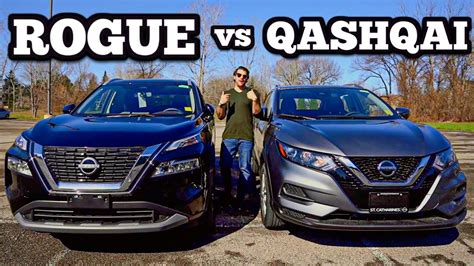
Nissan Qashqai vs Rogue: Unveiling the Subtle Differences
In the realm of compact SUVs, the Nissan Qashqai and Rogue stand as two prominent contenders. These vehicles have garnered widespread recognition for their blend of practicality, versatility, and style. However, beneath their apparent similarities, there lie subtle distinctions that set them apart.
Exterior Design: A Tale of Two Personalities
The Qashqai and Rogue exhibit distinct design philosophies. The Qashqai exudes a sleek and sporty demeanor, with sharp lines and a dynamic stance. Its angular headlights and pronounced grille lend it an aggressive presence. In contrast, the Rogue adopts a more conservative approach, featuring softer lines and a more understated appearance. Its rounded headlights and curvaceous grille project an air of sophistication and refinement.
Interior Space and Comfort: A Balancing Act
Both the Qashqai and Rogue offer ample interior space, catering to the needs of growing families and active lifestyles. However, the Rogue holds a slight edge in terms of overall passenger and cargo volume. Its spacious cabin provides ample legroom and headroom for all occupants, while the Qashqai offers a slightly more compact interior. Nevertheless, both vehicles feature comfortable and supportive seats, ensuring a pleasant ride for both short and long journeys.
Performance and Fuel Efficiency: A Delicate Balance
Under the hood, the Qashqai and Rogue offer a range of powertrain options to suit diverse driving requirements. The Qashqai comes standard with a 2.0-liter naturally aspirated four-cylinder engine that generates 141 horsepower and 147 pound-feet of torque. This engine is paired with a continuously variable transmission (CVT) that delivers smooth and efficient power delivery. The Rogue, on the other hand, offers a choice of two engines: a 2.5-liter naturally aspirated four-cylinder unit producing 170 horsepower and 175 pound-feet of torque, and a more potent 2.0-liter turbocharged four-cylinder engine that generates 225 horsepower and 258 pound-feet of torque. Both engines are mated to a CVT, striking a balance between performance and fuel efficiency.
Technology and Safety: Keeping Pace with the Digital Age
The Qashqai and Rogue come equipped with an array of advanced technologies, ensuring a connected and safe driving experience. Both vehicles offer user-friendly infotainment systems with touchscreen displays, Bluetooth connectivity, and smartphone integration. Additionally, they feature a comprehensive suite of safety features, including airbags, anti-lock brakes, traction control, and electronic stability control. The Rogue, however, goes a step further, offering additional driver assistance technologies such as lane departure warning, blind-spot monitoring, and adaptive cruise control, enhancing overall safety and convenience.
Pricing and Value: A Question of Cost-effectiveness
The Qashqai and Rogue occupy similar price brackets, making them direct competitors in the compact SUV market. However, the Qashqai offers a slightly more affordable starting price, making it an attractive option for budget-conscious buyers. Nevertheless, the Rogue's more extensive list of standard features and more powerful engine options may justify its slightly higher price tag for those seeking a more comprehensive and capable SUV.
Conclusion: Choosing the Right Companion for Your Journey
The Nissan Qashqai and Rogue are both excellent compact SUVs that cater to a wide range of driving needs and preferences. The Qashqai appeals to those who prioritize style, agility, and affordability, while the Rogue is a compelling choice for those seeking a more spacious interior, powerful engine options, and a comprehensive suite of safety and technology features. Ultimately, the decision between these two capable SUVs hinges on individual preferences, budget constraints, and the specific requirements of each driver.